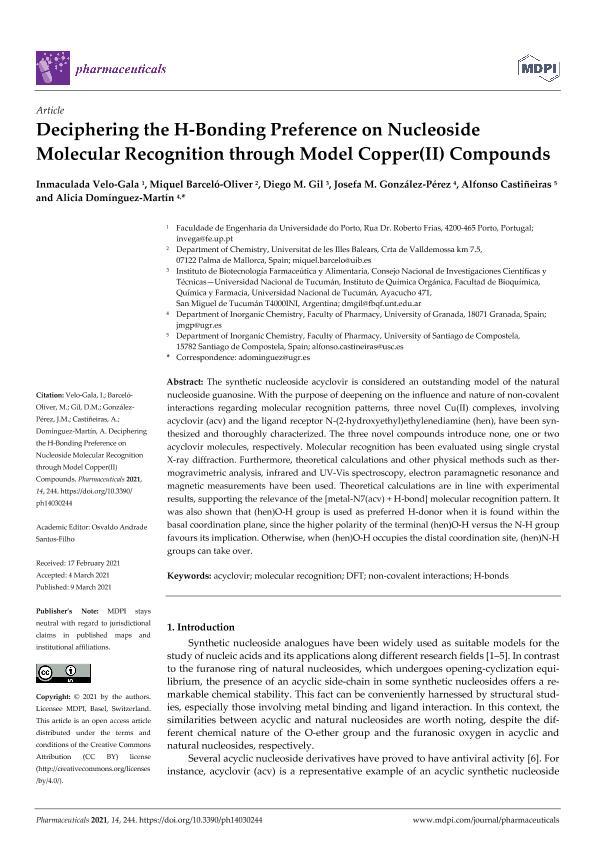Artículo
Deciphering the H-Bonding Preference on Nucleoside Molecular Recognition through Model Copper(II) Compounds
Velo Gala, Inmaculada; Barceló Oliver, Miquel; Gil, Diego Mauricio ; González Pérez, Josefa M.; Castiñeiras, Alfonso; Domínguez Martín, Alicia
; González Pérez, Josefa M.; Castiñeiras, Alfonso; Domínguez Martín, Alicia
 ; González Pérez, Josefa M.; Castiñeiras, Alfonso; Domínguez Martín, Alicia
; González Pérez, Josefa M.; Castiñeiras, Alfonso; Domínguez Martín, Alicia
Fecha de publicación:
03/2021
Editorial:
MDPI
Revista:
Pharmaceuticals
ISSN:
1424-8247
e-ISSN:
1424-8247
Idioma:
Inglés
Tipo de recurso:
Artículo publicado
Clasificación temática:
Resumen
The synthetic nucleoside acyclovir is considered an outstanding model of the natural nucleoside guanosine. With the purpose of deepening on the influence and nature of non-covalent interactions regarding molecular recognition patterns, three novel Cu(II) complexes, involving acyclovir (acv) and the ligand receptor N-(2-hydroxyethyl)ethylenediamine (hen), have been syn-thesized and thoroughly characterized. The three novel compounds introduce none, one or two acyclovir molecules, respectively. Molecular recognition has been evaluated using single crystal X-ray diffraction. Furthermore, theoretical calculations and other physical methods such as ther-mogravimetric analysis, infrared and UV-Vis spectroscopy, electron paramagnetic resonance and magnetic measurements have been used. Theoretical calculations are in line with experimental results, supporting the relevance of the [metal-N7(acv) + H-bond] molecular recognition pattern. It was also shown that (hen)O-H group is used as preferred H-donor when it is found within the basal coordination plane, since the higher polarity of the terminal (hen)O-H versus the N-H group favours its implication. Otherwise, when (hen)O-H occupies the distal coordination site, (hen)N-H groups can take over.
Palabras clave:
ACYCLOVIR
,
DFT
,
H-BONDS
,
MOLECULAR RECOGNITION
,
NON-COVALENT INTERACTIONS
Archivos asociados
Licencia
Identificadores
Colecciones
Articulos(INBIOFAL)
Articulos de INSTITUTO DE BIOTECNOLOGÍA FARMACEUTICA Y ALIMENTARIA
Articulos de INSTITUTO DE BIOTECNOLOGÍA FARMACEUTICA Y ALIMENTARIA
Citación
Velo Gala, Inmaculada; Barceló Oliver, Miquel; Gil, Diego Mauricio; González Pérez, Josefa M.; Castiñeiras, Alfonso; et al.; Deciphering the H-Bonding Preference on Nucleoside Molecular Recognition through Model Copper(II) Compounds; MDPI; Pharmaceuticals; 14; 3; 3-2021; 1-16
Compartir
Altmétricas



